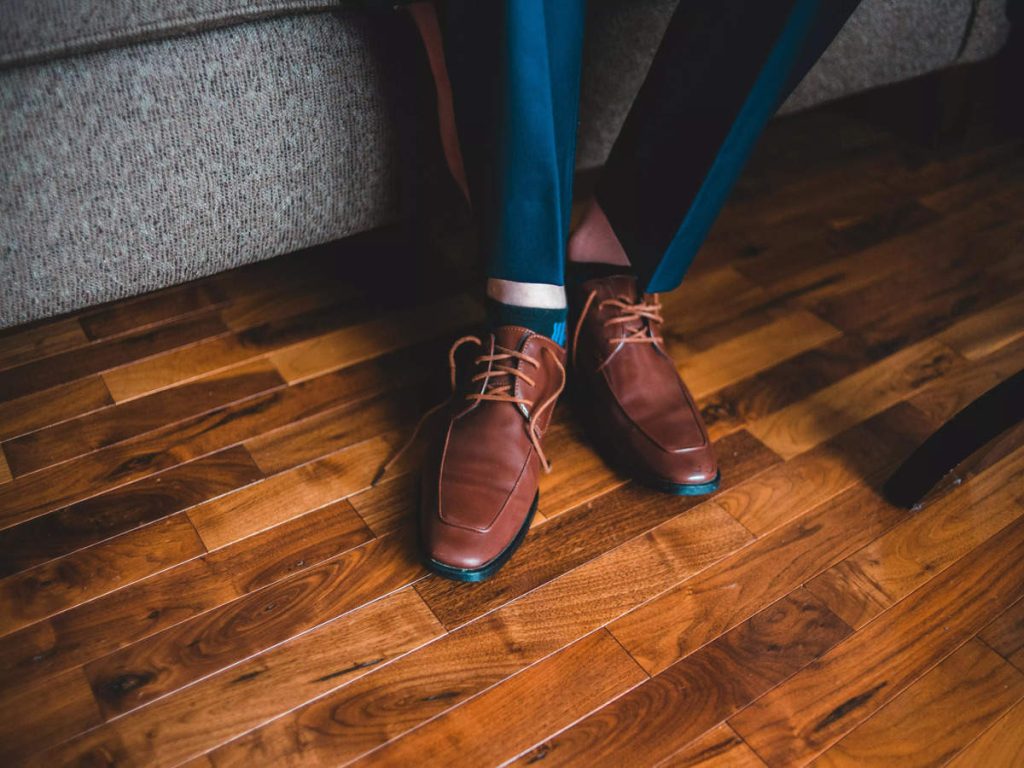In the course of excavations at Nerevskij End, remnants of the workshops of shoemakers and beamhouses were discovered. Shoes made of leather dating from the 11th-16th century were also found.
The process of preparing the leather for shoemaking began with a bath. The hide was cleaned of any remaining subcutaneous and flesh tissue using iron adzes.
Russian shoemaking tradition
In the 12th century, shoemakers started using various types of bast. The bark from birch oak, the linden tree or the elm tree was removed and mixed into the bast. It was then stored. Afterwards, it was divided into strips, which were then utilized to weave the lapti. The strips were weaved using either straight or diagonal weaving as well as the shoes were decorated by stamping or embroidery.
Lapti were the most common footwear for the average person. The simplicity, comfort and low cost of these shoes helped make them very popular. They were worn until the beginning of the Russian Civil War. Then, the mass production of leather footwear began to replace them.
In the 16th-17th centuries there was a different kind of foot-wear that was popular among ordinary people — porshni, that were essentially low-heeled shoes. This type of shoe was found only in urban excavations. The shoes were made from rawhide ox, however they featured a felt top as well as the sole was made of leather.
Leather shoe industry in Russia
The 10th–11th centuries were when Novgorod tanners produced rawhide [Rus. syromiatnaia, syromjatnaja], that was not tanned, it was it was kneaded, then soaked in fat. Leatherworkers used it to make belts, tackle and a style of footwear called “bog shoes”. porshni]. The symmetrical shoes (left and right) found in the dig suggest that the shoemakers used a special last to shape the stone.
It is worth noting that the earliest bog shoes had stamped patterns on their sides similar to the decorative designs on pouches (Rus. kosheliok, koshelek). It was a popular method to embellish leather. Later, the patterns were made with silk or wool thread.
Novgorod is the place where the oldest leather shoes preserved in Russia have been found. They were different from one another. Some were low, and reached the ankle; others had a collar around the ankle which was similar to boots. Many pairs of these Mulgati shoes belonged to aristocrats and boysars that were depicted on art monuments.
Lapti was a very popular type of footwear among the Russian peasantry in medieval times. Old, ragged lapti would be placed on fences or inside homes in order to keep out the evil spirits that an unwelcome guest could bring. Additionally, old lapti were utilized to transport the domovoi (house spirit) from one residence to another in the event that families were moving.

Evolution of Russian leather footwear
The archaeological evidence suggests that Novgorod shoemakers manufactured shoes for all classes of people including peasants and artisans. The shoemakers also made footwear for the wealthy princes and boyars, as depicted in art works. In the 11th-12th centuries, shoemakers’ craftsmanship was significantly improved. The simple carving and embroidery of earlier shoes gave way to elaborate openwork patterns.
The 13th century was when soft shoes appeared (Rus. porshni]. In Vjatichi burial grounds the remains of shoes with soles that were flat have been found. The sole, upper, heel quarter and bootleg of these shoes are made from a softer leather than the sole. A lined [podnariad], podnarjad] was sewn between the two halves of the upper.
A distinctive feature of these shoes was thick Russian leather (lapti). The leather was crafted from animal hides that were tanned using barks from oak, birch, linden and other trees. This leather was famous for its longevity, a distinctive aroma and unique hatched texture.
The 17th and 16th centuries saw the introduction of different types of footwear in Europe. These boots became the standard winter boots of Russian peasants during the 19th century. They are still a part of traditional Russian attire and are now a symbol of Russia’s cultural heritage. They are made from high natural leather that has an asymmetric last that corresponds to the position of the foot and leaves space for the toes.
Russian shoe brands
In Russia the production of leather shoes is responsible for more than 10% of Russia’s manufacturing of footwear. It is among the most important industrial sectors that is constantly expanding due to the growing demand for high-quality leather shoes. To satisfy this growing demand, several companies in the industry of leather shoes have sprung up in Russia. These include the Vakhrushi-Litobuv and Technoavia companies and both are based in Yoshkar-Ola.
Vakhrushi-Litobuv is the most renowned supplier in Russia of safety footwear made from leather. It sells its shoes to Mosvodokanal>> Management Company LLC and North-West>(formerly known as PJSC as well as Bashkiravtodor>and Bashkiravtodor> JSC. It also sells a selection of leather casual shoes.
Technoavia is in operation since 1992. The plant located in Yoshkar-Ola has four injection molding machines Desma, which allow it to make footwear using PU/PU and PU/TPU soles. Technoavia is the sole manufacturer of leather safety boots that are insulated in the nation.
It was the first company to utilize “Russian Leather”, a leather made out of the skins of Southern German cows and sealed with wax and oil. This leather has a deep hue, which ranges from dark claret to sienna, and it is characterized by a scent of sweetness. It is extremely durable and resistant to stains.
